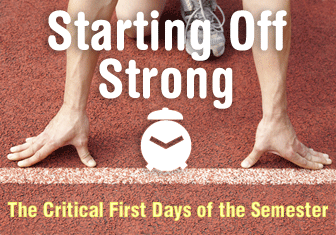The Rhythm of the Semester: What to Expect


However, it’s important to assure to the best of your ability that bad days don’t occur in the first couple of weeks of school, even with their increased probability of things going wrong. These first days are the students’ first glimpse of you and the class, possibly also of the school. It doesn’t take much to scare off a student in this early period. However, present students with a calm demeanor and a well-run class, and they become your dedicated students.
It seems obvious, but the elementary step of learning students’ names is really key to having a good semester and to classroom control. It is very hard to ask students to do something, for example, like stop talking or move into groups, If you don’t know their names. And of course learning student names is the first step to learning who students are as individuals, which is vitally important to teacher effectiveness. It is through knowing students as individuals, their backgrounds, likes, and dislikes that a relationship and knowing how to teach the individual student is based on. On the first day of class, having students fill out a profile in which they include information on their first language, prior language experiences, favorite books or movies, and hobbies, helps toward this end of knowing your students.
As important as knowing who your students are as individuals is knowing who they are as learners. On the learner profile that students fill out at the beginning of the semester also get information as to the students’ educational background: prior college experience and English learning experience, for example. This can inform how you will structure the rest of the course. A class of students who have been mostly educated in another country has different learning needs than the ESL class of mostly U.S.-educated students: the latter class has much more knowledge of U.S. culture, of course, and therefore might need more focus on academic English than the foreign-educated group, who may have strong academic skills but less understanding of U.S. culture.
You can also by gathering initial information get to know individual student learning needs as well as the overall class needs: which students seem to learn better in groups and which seem to prefer learning individually, for example, and who the kinesthetic learners and who the visual learners are. Knowing which strategies you will need to emphasize for your students will increase your effectiveness as a teacher.
Also of vital importance toward this goal of effective instruction is knowing the curriculum in relation to learners, and gauging students’ prior skills related to the curriculum. A diagnostic or pretest of some sort is important to see how prepared students are for the course content. I make my diagnostics informal and ungraded, such as a short writing sample on “A Life Lesson.” Having this pretest is helpful because if I had planned to spend little time in my writing class on the paragraph, for example, moving into the essay rather rapidly, but the pretest reveals that most students don’t know how to structure a paragraph with topic sentence and supporting details, this will indicate I’ll have to restructure my syllabus, spending more time on paragraph structure before moving on to the essay. The curriculum should be adjusted to meet student needs in most cases, rather than adjusting the student population to meet curricular needs. There are exceptions to this, of course; sometimes a diagnostic might reveal that a student has so few of the needed skills for my class that I will advise a lower level class—or there are rare times when the student can actually move up to a higher level class. At any rate, there should be a fit between the curriculum and students that should be addressed at the beginning of the semester, not left until midterms, when it will be too late for students to change classes.
After the preliminary information on the students and their skills is gathered, this can be used to implement a syllabus and routines for the course. For example, if you have a group of mostly new speakers of English educated in places outside of the U.S., you can start each period with a short time for small talk just to get students used to speaking English informally, as well as plenty of short, activities focused on practice of conversational skills and small, low-stakes quizzes. More advanced speakers of English or those with more exposure to U.S. culture might be bored with such a curriculum, and focus on more advanced academic skills, such as reading a number of essays or a short novel with attendant writing practice, would be more appropriate. Also at an advanced level more focus on refining pronunciation and acquiring a more academic vocabulary and grammar are more relevant than conversational and fluency practice. All the information gathered on student learning needs informs the general outline for the course.
Once I have the information for the semester’s schedule, I can plan the daily routine. If students need work on writing skills, for example, I might plan to spend a part of each meeting in journal writing for fluency. The beginning part of the semester is also a time to establish with students the protocol for entering a class late, finding papers, what to do in the case of absence, and so forth. Having students learn these routines contribute greatly to a class that runs smoothly with few interruptions.
However, through learning about your students and implementing a sound curriculum and set of routines, a strong beginning that sets up a sound middle and a wonderful end is assured.